| 1 | A short yet thick python |
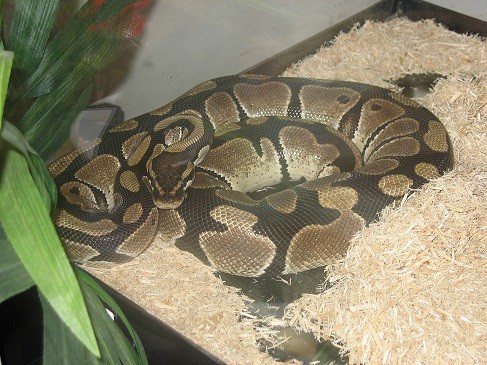
The ball python (Python regius) is a common species of Africa, which is completely harmless to human beings and is extremely popular around the world as a pet. This is one of 4 members of the true Python genus found in Africa, also including the rare Anchiete’s python and the two African rock pythons, which are some of the longest snakes worldwide. An adult rock python can exceed 5 metres, while ball pythons are significantly shorter, but still decently large, with an average length of 100-150cm.
Ball pythons are found mainly in west Africa. To the east, their empire reaches Nigeria and Cameroon, where they’re very common. They cross through Togo, Ghana, Benin and Ivory Coast, before reaching a strong Atlantic coast colony in Senegal and Guinea. The furthest east they reach is northwest Uganda.
Ball pythons are relatively short, yet have a crushingly thick body, which they use to constrict small mammals such as striped mice. Ball pythons almost never bite humans, and consequently, they rank in the top 5 for most popular captive snakes worldwide, alongside corn snakes and boa constrictors.
Ball pythons are easy to spot in Africa, as their patterns are very vivid. Instead of narrow stripes, the ball python has large brown blotches splashed against a dark brown background. Some ball pythons have yellow stripes running from the nose to their eyes, while the belly is an ivory white. They have a far thinner head than the centre of their body, and the longest individual on record measured 1.83 metres.
| 2 | Worshipped in Ghana |
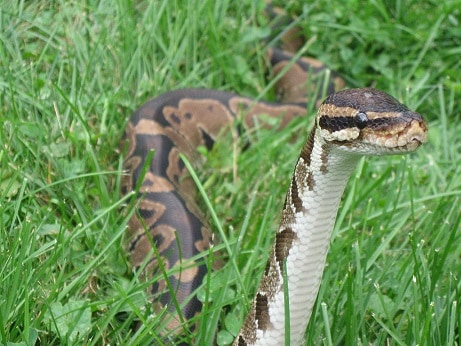
Unlike the black mamba and the superstitious fear surrounding it, the ball python is a widely worshipped snake. Ghana in particular has beliefs stretching back centuries. Afife in the Volta region is mainly populated by the Ewe ethnicity, who consider the ball python to be the god who guided them on their migration from Togo nearly 200 years ago. Killing ball pythons is taboo in this region of Ghana, and if your hand slips then the penalty is severe: the offender must shave every hair on his body, and walk back to Afife with dead python strapped to his head. Every February, residents of Afife hold an annual ball python festival, and in 1996 they even set up roadblocks to prevent people from carelessly running the snakes over.
Somanya is another Ghanaian region (population 20,000) where killing ball pythons is taboo, as is touching them or bothering them in any way. Ghanaians here believe that a ball python slithering into the house is a blessing, and requires an immediate libation ceremony in response, with rice or grains being poured as an offering.
| 3 | Worshipped in Benin and Nigeria |

The ball python’s other common name is the royal python, and this is believed to have originated from ancient African kings, who supposedly draped the live snake around their neck as jewellery. Nigeria also has a set of folk beliefs, particularly the Igbo people, who build coffins for ball pythons and conduct a short funeral whenever one perishes.
The Igbos believe that in the beginning all was water, in a vast unbroken sea called Oshimirri. Eventually, Oshmirri dried out and became Ala, the Igbo name for Earth, with only rivers and streams remaining. The ball python is believed to be the messenger of Ala, who the Igbo people must negotiate with in order to inhabit the Earth, since it dwelled there before them.
Meanwhile, Beninese villagers have worshipped the ball python for at least 600 years. Portuguese colonists in the 16th century built a cathedral directly opposite the local ball python shrine, possible to sway the locals. The grandest temple of all (the Vatican city of ball python temples) stands in Oudah, Dahomey, and in the nearby farms the ball pythons are allowed to roam freely, with some farmers bringing in an extra helping. It’s a cooperative man-snake relationship, and the nearby granaries are raised on stilts in order to store grain away from the rodents, with the pythons patrolling the floor as guards.
| 4 | Named after ball manoeuvre |
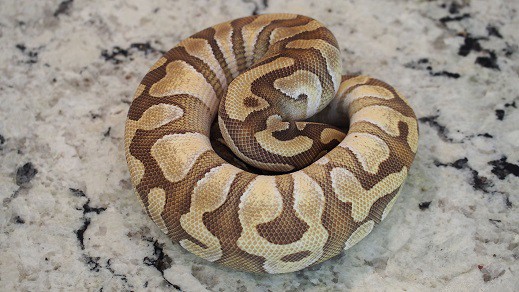
If the royal python name is derived from ancient kings, then the ball python name is much simpler. It comes from the species’ defensive manoeuvre: curling itself into a tight ball with its head protected in the centre. Rather than fleeing up a tree or viciously biting the aggressor, this is the ball python’s default defensive tactic if approached by a bird or human. It differs to the boomslang, which tends to flee, and the trinket snake of India, which lacks venom yet stands its ground and fights with everything it has.
Ball pythons can be impossible to unwind by force once they’ve set up this ball shape, and they even stay in their tight balls when rolled around. That said, the ball python will launch a surprise vicious bite occasionally. Ball pythons are one of the most popular captive snakes worldwide, and many keepers discover this hidden aggression with the cost of a bleeding hand.
If a captive ball python curls up, then it’s probably scared or stressed, and the advice is to back off and leave it in peace for a while. In fact, some keepers become concerned when their ball python doesn’t ball up, when it actually means that their pet has grown comfortable around them.
| 5 | Males live in trees, females burrows |
Ball pythons are found exclusively south of the Sahara desert, as they avoid extremes of habitats. They’re never found in rainforests alongside hairy bush vipers, nor do they surf along sand dunes like the Saharan horned viper.
Instead, ball pythons prefer open fields and sparsely forests areas. In particular, they’re attracted to West African farmland, where the endless rodents present an irresistible food supply. They’re like an African version of the Indian Russell’s viper, except that they’re non-venomous and farmers actually like them. They have numerous animal neighbours on these farms, including African giant snails, giant centipedes, red-tailed skinks, and black cobras.
Ball pythons are often considered to be an underground species, but there’s a particularly big difference between the genders. Females are far more land-faring and will retreat to burrows or termite mounds at night, but males are semi-arboreal. In one study in Nigeria, 50% of male ball pythons encountered over 2 years were spotted in trees, despite having a far bulkier body compared to the nimble golden tree snake.
| 6 | Males eat birds, females mammals |
For a long time, ball pythons were believed to mainly be rodent eaters. Then came a mysterious situation in captivity, where male snakes were much more reluctant to eat the mice which females greedily devoured. It transpired that in line with their tree-dwelling nature, male ball pythons rely on birds far more heavily than females.
Some species include doves, weaver birds and starlings, and even grey parrots (Psittacus erithacus). Ball pythons are active foragers rather than ambush predators, and probably sneak up on the birds as they roost. Male ball pythons eat mammals as well, though less than females, and species found in their bellies include shrews and striped mice.
Females have a far wider menu of mammals, being known to eat fruit bats (Megaloglossus woermanni), soft-furred mice (Praomys tullbergi), and Gambian pouched rats (Cricetomys gambianus). One large animal they’re confirmed to eat is the giant forest squirrel (Protoxerus stangeri), which has a 1 foot long body and a tail measuring another foot, which is hefty considering the ball python’s length of 1-1.5 metres.
| 7 | Under pressure from worldwide trade |
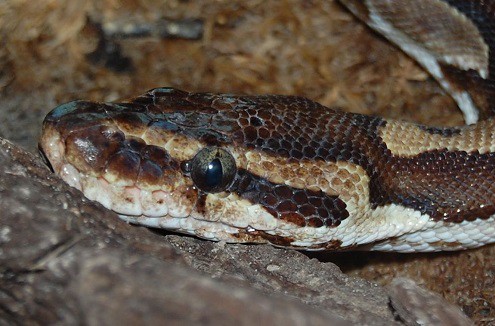
Alongside the corn snake, the ball python is one of the most popular captive snakes kept worldwide. It’s the single most commonly legally traded animal in Africa, and Canada alone has 28,000 ball pythons kept as pets. This has led to fears over the species’ survival in its native Africa. Officially, the ball python isn’t endangered, but since 1975, over 3 million have been exported to international waters. In 2005, 250,000 were exported worldwide, and the years since 2007 have seen an average of 100,000 exports.
There’s also fears over the colourful morphs that breeders have created, namely that they cause neurological disorders. One captive morph is the spider morph, which has yellow-black patterns like a cracked cheetah. The spider morph is correlated with a condition called wobble-head, where the head tilts and spasms uncontrollably. Other morphs have skull deformities and “bug eye” syndrome.
Some countries have introduced a ranching system where they breed ball pythons and release some newborns back into the wild. The flaw is that because the mothers were captured from the wild, the ranchers are only giving back eggs that would have been laid in the wild anyway.
| 8 | Secrets of a ball python hunter |
Capturing ball pythons is a full time job and most trappers begin immediately after sunrise, skip the hottest part of the day, and then work for the rest of the afternoon. They often search in cassava patches, rough fields and fallow thickets, but never bother with semi-flooded grassland, as ball pythons are never found there.
Trappers usually begin right next to villages, and often find their first ball python 50 metres from nearby houses. The basic strategy is to find ball python burrows and demolish them as they sleep during the day. Some strategies include following a snake trail through the soil (identifying the species with their vast experience), searching for shed skin at the entrance, and seeking burrows with the smoothed down entrance that only a slither can create. The trappers also smell the burrow entrances, and one study estimated their success rate at guessing the species inside at 90%. They also seek out termite mounds, and demolishing them can take 1 hour, versus a few minutes for burrows.
Despite this relentless trade, there’s some happier news for the species. 99% of ball python hunting takes place in three countries: Ghana, Togo, and Benin. Consequently, the species is much safer across the rest of its range, and particularly safe havens which worship them such as Nigeria.
| 9 | Can give birth at 60 |
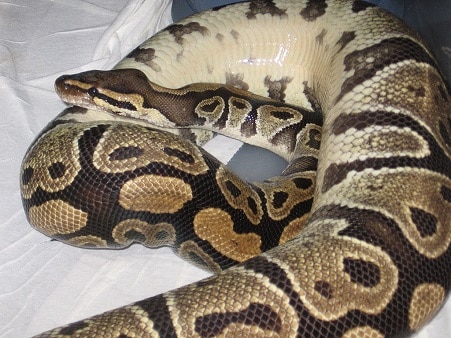
Ball pythons may be one of the longest lived snake species on Earth, beating even the corn snake (and easily beating the surprisingly short-lived garter snake). The mere average lifespan in captivity is 20 years, and several zoos have reported higher figures: 28 years at Oakland zoo, 50 years at Philadelphia zoo, and a stonking 62 years at the Saint Louis Zoo in Missouri.
This elderly snake was given to the zoo by a private donor in 1961, when it was estimated at 3 years old. In 2020, the female python shocked the world by giving birth to 7 eggs, being far older than the maximum possible age for human birth (except incredible rarities).
The most amazing part was that she hadn’t been in contact with a male for 15 years. Other snakes such as the elephant trunk can store sperm for 7 years, but this was a new record. The ball python is blasting through the boundaries of longevity all over the place. In the wild, they routinely lay at eggs at up to 30 years old.
| 10 | Best of the rest |
The ball python’s balling tactics aren’t just deployed to protect themselves, but their eggs too. Females are capable of laying eggs at 27 months old, and the clutch size varies from 1-11. The eggs are white and adhere to each other in large clumps, until just a few days before hatching, when they finally start to separate. During this time, the mother will curl around the eggs to deter predators, before the 25-43cm long hatchlings finally hack their way free using their egg tooth.
Because of their thick, bulky bodies, ball pythons are a slow-moving snake species. When hunting they’re mostly reliant on their eyesight, particularly ultraviolet light frequencies, unlike the desert horned viper and its vibration-sensing techniques.
Ball pythons also have pelvic spurs, short protrusions like spikes which sometimes cause confusion among people who buy them. Pythons are a particularly primitive family of snakes, and these are the last vestiges of legs from their lizard ancestors. In the wild, the ball python uses them to grip females.
